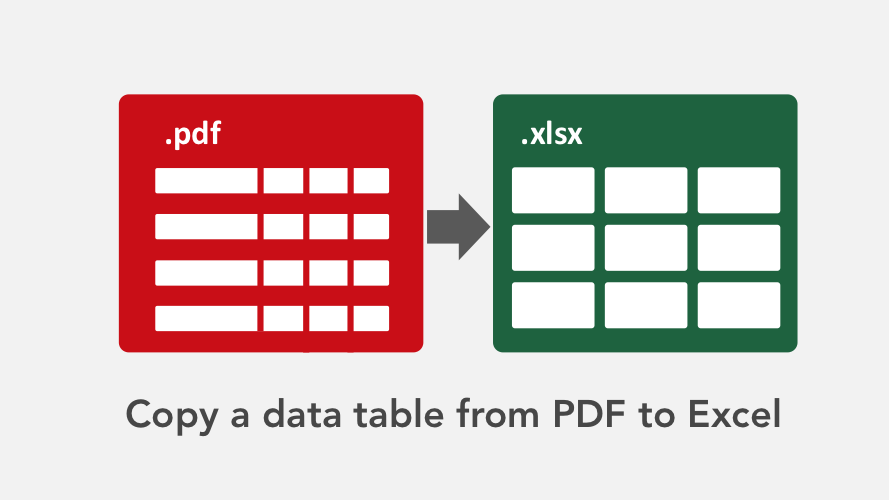Bridging the Gap: A Comprehensive Guide on How to Copy Tables from PDF to Excel with Precision

Introduction:
PDFs have become a ubiquitous format for document sharing, but extracting data from PDFs for use in other applications, such as Microsoft Excel, can be a common challenge. Tables, in particular, are frequently encountered in PDF documents, and understanding how to copy them to Excel efficiently is a valuable skill. In this detailed guide, we will explore various methods, tools, and best practices to help you seamlessly transfer tables from PDF to Excel, ensuring accuracy and preserving the integrity of your data.
Understanding the Challenge:
PDFs, or Portable Document Format files, are designed to retain the formatting and layout of documents across different platforms. While this is advantageous for preserving the original document’s appearance, it can complicate the extraction of data, especially when dealing with tables. The challenge arises from the fact that PDFs are essentially images or vector graphics, and traditional copying and pasting methods may not work as expected.
Method 1: Manual Copy-Paste from PDF to Excel
- Open PDF and Excel:
- Open the PDF file containing the table you want to copy and Microsoft Excel on your computer.
- Select and Copy:
- Using your cursor, select the table in the PDF. Right-click and choose “Copy” or use the keyboard shortcut (Ctrl + C on Windows or Command + C on Mac).
- Paste into Excel:
- Switch to the Excel workbook where you want to paste the table. Right-click in the desired cell and choose “Paste” or use the keyboard shortcut (Ctrl + V on Windows or Command + V on Mac).
- Adjust Formatting:
- Depending on the complexity of the table, you may need to adjust formatting, column widths, and row heights in Excel to match the original table.
- Verify Data:
- Double-check the data in Excel to ensure accuracy, as manual copying can sometimes introduce errors.
While this method is straightforward, it may not be ideal for complex tables or large datasets, and adjustments might be needed to align the data correctly.
Method 2: Using Adobe Acrobat (For Structured Tables)
- Open PDF in Adobe Acrobat:
- Open the PDF file in Adobe Acrobat, the industry-standard PDF reader.
- Select Table:
- Click on the “Select” tool in Adobe Acrobat and drag to select the entire table.
- Copy as Table:
- Right-click on the selected table, and from the context menu, choose “Export Selection As” > “Excel.” This will open Excel and paste the table directly.
- Adjust Formatting (if needed):
- Fine-tune formatting as necessary to match your requirements.
Using Adobe Acrobat can yield more accurate results, especially for well-structured tables, but it may require access to the paid version of the software.
Method 3: Online Tools for Conversion
Several online tools specialize in converting PDF tables to Excel format. These tools often follow a similar process:
- Upload PDF:
- Visit an online PDF to Excel converter tool. Upload your PDF file.
- Select Options:
- Choose the options relevant to your table, such as adjusting the detection of rows and columns.
- Convert and Download:
- Initiate the conversion process, and once complete, download the converted Excel file.
Popular online tools for PDF to Excel conversion include SmallPDF, PDFTables, and Cometdocs. However, exercise caution when using online tools, especially with sensitive or confidential data.
Best Practices and Tips:
- Check for OCR (Optical Character Recognition):
- Some PDFs contain scanned images rather than text. Ensure that OCR has been applied to recognize and extract text from these images.
- Verify Data Accuracy:
- Always verify the accuracy of the transferred data, especially for numerical values and special characters.
- Clean Up Extraneous Elements:
- After pasting the table into Excel, check for and remove any extraneous elements that may have been copied, such as extra columns or rows.
- Use External Excel Add-ins:
- Some external Excel add-ins, like Able2Extract or Tabula, can assist in extracting tables from PDFs. Explore and install trusted add-ins based on your requirements.
- Consider Text-to-Columns:
- If the pasted data appears in a single column, use the “Text to Columns” feature in Excel to split it into multiple columns based on delimiters.
- Use Excel’s Data Import Feature:
- Excel has built-in features for importing data from various sources. Explore the “Data” tab and use the “Get Data” or “From Text” options to import data from a text file, which can include tables copied from PDFs.
Conclusion:
Mastering the art of copying tables from PDF to Excel is a valuable skill, unlocking the potential to leverage data from diverse sources. Whether using manual methods, specialized software like Adobe Acrobat, or online conversion tools, the key lies in maintaining accuracy and ensuring that the extracted data aligns with your intended use. As you navigate the intricate world of data extraction, adopt the methods that best suit your needs, and employ the best practices outlined in this comprehensive guide to seamlessly transfer tables from PDFs to Excel with precision and efficiency.




